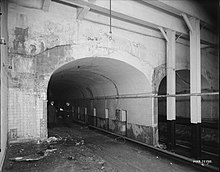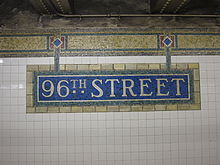New York City Subway station in Manhattan, New York
| 96 Street | ||||||||||||||||||||||||||||||||||||||||||||||||||||||||||||||||||||
|---|---|---|---|---|---|---|---|---|---|---|---|---|---|---|---|---|---|---|---|---|---|---|---|---|---|---|---|---|---|---|---|---|---|---|---|---|---|---|---|---|---|---|---|---|---|---|---|---|---|---|---|---|---|---|---|---|---|---|---|---|---|---|---|---|---|---|---|---|
 Northbound platform Northbound platform | ||||||||||||||||||||||||||||||||||||||||||||||||||||||||||||||||||||
| Station statistics | ||||||||||||||||||||||||||||||||||||||||||||||||||||||||||||||||||||
| Address | East 96th Street & Lexington Avenue New York, New York | |||||||||||||||||||||||||||||||||||||||||||||||||||||||||||||||||||
| Borough | Manhattan | |||||||||||||||||||||||||||||||||||||||||||||||||||||||||||||||||||
| Locale | Carnegie Hill & East Harlem | |||||||||||||||||||||||||||||||||||||||||||||||||||||||||||||||||||
| Coordinates | 40°47′09″N 73°57′03″W / 40.785773°N 73.950949°W / 40.785773; -73.950949 | |||||||||||||||||||||||||||||||||||||||||||||||||||||||||||||||||||
| Division | A (IRT) | |||||||||||||||||||||||||||||||||||||||||||||||||||||||||||||||||||
| Line | IRT Lexington Avenue Line | |||||||||||||||||||||||||||||||||||||||||||||||||||||||||||||||||||
| Services | 4 (late nights) 6 (all times) <6> (weekdays until 8:45 p.m., peak direction) | |||||||||||||||||||||||||||||||||||||||||||||||||||||||||||||||||||
| Transit | ||||||||||||||||||||||||||||||||||||||||||||||||||||||||||||||||||||
| Structure | Underground | |||||||||||||||||||||||||||||||||||||||||||||||||||||||||||||||||||
| Platforms | 2 side platforms | |||||||||||||||||||||||||||||||||||||||||||||||||||||||||||||||||||
| Tracks | 2 | |||||||||||||||||||||||||||||||||||||||||||||||||||||||||||||||||||
| Other information | ||||||||||||||||||||||||||||||||||||||||||||||||||||||||||||||||||||
| Opened | July 17, 1918 (106 years ago) (1918-07-17) | |||||||||||||||||||||||||||||||||||||||||||||||||||||||||||||||||||
| Opposite- direction transfer | No | |||||||||||||||||||||||||||||||||||||||||||||||||||||||||||||||||||
| Traffic | ||||||||||||||||||||||||||||||||||||||||||||||||||||||||||||||||||||
| 2023 | 3,760,351 | |||||||||||||||||||||||||||||||||||||||||||||||||||||||||||||||||||
| Rank | 80 out of 423 | |||||||||||||||||||||||||||||||||||||||||||||||||||||||||||||||||||
| ||||||||||||||||||||||||||||||||||||||||||||||||||||||||||||||||||||
| ||||||||||||||||||||||||||||||||||||||||||||||||||||||||||||||||||||
| ||||||||||||||||||||||||||||||||||||||||||||||||||||||||||||||||||||
| ||||||||||||||||||||||||||||||||||||||||||||||||||||||||||||||||||||
| ||||||||||||||||||||||||||||||||||||||||||||||||||||||||||||||||||||
The 96th Street station is a local station on the IRT Lexington Avenue Line of the New York City Subway. Located at the intersection of Lexington Avenue and 96th Street in the Carnegie Hill and East Harlem neighborhoods of Manhattan, it is served by the 6 train at all times, the <6> train during weekdays in the peak direction, and the 4 train during late nights.
This station was constructed as part of the Dual Contracts by the Interborough Rapid Transit Company and opened in 1918. It was renovated in the 1990s.
History


Following the completion of the original subway, there were plans to construct a line along Manhattan's east side north of 42nd Street. The original plan for what became the extension north of 42nd Street was to continue it south through Irving Place and into what is now the BMT Broadway Line at Ninth Street and Broadway. In July 1911, the IRT had withdrawn from the talks, and the Brooklyn Rapid Transit Company (BRT) was to operate on Lexington Avenue. The IRT submitted an offer for what became its portion of the Dual Contracts on February 27, 1912.
In 1913, as part of the Dual Contracts, which were signed on March 19, 1913, the Public Service Commission planned to split the original Interborough Rapid Transit Company (IRT) system from looking like a "Z" system (as seen on a map) to an H-shaped system. The original system would be split into three segments: two north–south lines, carrying through trains over the Lexington Avenue and Broadway–Seventh Avenue Lines, and a west–east shuttle under 42nd Street. This would form a roughly H-shaped system. It was predicted that the subway extension would lead to the growth of the Upper East Side and the Bronx.
The 96th Street station opened on July 17, 1918, with service initially running between Grand Central–42nd Street and 167th Street via the line's local tracks. On August 1, the "H system" was put into place, with through service beginning on the new east and west side trunk lines, and the institution of the 42nd Street Shuttle along the old connection between the sides. The cost of the extension from Grand Central was $58 million.
The city government took over the IRT's operations on June 12, 1940. The station was renovated in the 1990s, and had its original tilework restored.
Station layout
| Ground | Street level | Exit/entrance |
| Mezzanine | Fare control, station agent, MetroCard machines | |
| Platform level | Side platform | |
| Northbound local | ← ← | |
| Southbound local | → → | |
| Side platform | ||
| Express tracks | Northbound express | ← |
| Southbound express | → | |

The station has two local tracks and two side platforms. The 6 stops here at all times, and the 4 stops here during late nights. The express tracks run on a lower level and are not visible from the platforms. The station is between 103rd Street to the north and 86th Street to the south.
A crossover is provided, with a mosaic in the mezzanine entitled City Suite, commissioned in 1994. There are new "96th Street" mosaics, and a window in the mezzanine overlooks the tracks, giving a view of oncoming trains from the south. The south end of the station features a rounded ceiling due to problems encountered during construction. Both platforms have emergency exits from the lower level express tracks.
Exits
The station has staircases leading to all four corners of the intersection of Lexington Avenue and 96th Street.
References
- "Glossary". Second Avenue Subway Supplemental Draft Environmental Impact Statement (SDEIS) (PDF). Vol. 1. Metropolitan Transportation Authority. March 4, 2003. pp. 1–2. Archived from the original (PDF) on February 26, 2021. Retrieved January 1, 2021.
- "Manhattan Bus Map" (PDF). Metropolitan Transportation Authority. July 2019. Retrieved December 1, 2020.
- ^ "Lexington Av. Line to be Opened Today" (PDF). The New York Times. July 17, 1918. p. 13. ISSN 0362-4331. Archived (PDF) from the original on December 14, 2021. Retrieved April 21, 2020.
- ^ "Annual Subway Ridership (2018–2023)". Metropolitan Transportation Authority. 2023. Retrieved April 20, 2024.
- Walker, James Blaine (1918). Fifty Years of Rapid Transit — 1864 to 1917. New York, N.Y.: Law Printing. pp. 230–233. Retrieved November 6, 2016.
- "Petition for Subway in Lexington Ave". The New York Times. May 22, 1912. ISSN 0362-4331. Archived from the original on May 4, 2022. Retrieved February 16, 2009.
A petition is being circulated among the residents and property owners of the section just south of the Grand Central Station, in Park and Lexington Avenues, protesting against the proposed abandonment of the construction of the Subway in Lexington Avenue, between Forty-third and Thirty-second Streets.
- "Subway Contracts Solemnly Signed; Cheers at the Ceremonial Function When McCall Gets Willcox to Attest" (PDF). The New York Times. March 20, 1913. ISSN 0362-4331. Archived (PDF) from the original on May 4, 2022. Retrieved January 11, 2018.
- "Money Set Aside For New Subways; Board of Estimate Approves City Contracts to be Signed To-day with Interboro and B.R.T." (PDF). The New York Times. March 19, 1913. ISSN 0362-4331. Archived (PDF) from the original on July 7, 2021. Retrieved November 10, 2017.
- Engineering News-record. McGraw-Hill Publishing Company. 1916. p. 846. Archived from the original on May 4, 2022. Retrieved December 28, 2020.
- Whitney, Travis H. (March 10, 1918). "The Seventh and Lexington Avenue Subways Will Revive Dormant Sections — Change in Operation That Will Transform Original Four-Tracked Subway Into Two Four-Tracked Systems and Double Present Capacity of the Interborough". The New York Times. p. 12. Archived from the original on May 4, 2022. Retrieved August 26, 2016.
- "Public Service Commission Fixes July 15 For Opening of The New Seventh and Lexington Avenue Subway Lines — Will Afford Better Service and Less Crowding — Shuttle Service for Forty-Second Street — How the Various Lines of the Dual System Are Grouped for Operation and List of Stations on All Lines". The New York Times. May 19, 1918. p. 32. Archived from the original on May 4, 2022. Retrieved November 6, 2016.
- "Lexington Subway to Operate To-day". New York Herald. July 17, 1918. p. 8. Retrieved May 30, 2023.
- "Open New Subway Lines to Traffic; Called a Triumph — Great H System Put in Operation Marks an Era in Railroad Construction — No Hitch in the Plans — But Public Gropes Blindly to Find the Way in Maze of New Stations — Thousands Go Astray — Leaders in City's Life Hail Accomplishment of Great Task at Meeting at the Astor". The New York Times. August 2, 1918. p. 1. Archived from the original on January 6, 2021. Retrieved November 6, 2016.
- "New "H" System Brings Worst Subway Jam". New-York Tribune. August 2, 1918. pp. 1, 6. Retrieved May 30, 2023.
- "Finish a New Link of the Dual Subway; Lexington Avenue Line North of Forty-second Street to Begin Local Service Wednesday. Branch Extends to Bronx Through service, with Times SquareGrand Central Shuttle Connections, to Open Soon. Changes in the Bronx". The New York Times. July 11, 1918. p. 20. ISSN 0362-4331. Archived from the original on May 4, 2022. Retrieved January 8, 2017.
- "City Transit Unity Is Now a Reality; Title to I.R.T. Lines Passes to Municipality, Ending 19-Year Campaign". The New York Times. June 13, 1940. ISSN 0362-4331. Archived from the original on January 7, 2022. Retrieved May 14, 2022.
- "Transit Unification Completed As City Takes Over I. R. T. Lines: Systems Come Under Single Control After Efforts Begun in 1921; Mayor Is Jubilant at City Hall Ceremony Recalling 1904 Celebration". New York Herald Tribune. June 13, 1940. p. 25. ProQuest 1248134780.
- Station Reporter — 6 Train
- "4 Subway Timetable, Effective December 15, 2024". Metropolitan Transportation Authority. Retrieved December 16, 2024.
- "6 Subway Timetable, Effective December 15, 2024". Metropolitan Transportation Authority. Retrieved December 16, 2024.
- Dougherty, Peter (2006) . Tracks of the New York City Subway 2006 (3rd ed.). Dougherty. OCLC 49777633 – via Google Books.
- "Subway Map" (PDF). Metropolitan Transportation Authority. September 2021. Retrieved September 17, 2021.
- "96th Street Neighborhood Map". mta.info. Metropolitan Transportation Authority. April 2018. Archived from the original on December 27, 2021. Retrieved December 28, 2020.
External links
- nycsubway.org – IRT East Side Line: 96th Street
- nycsubway.org — City Suite Artwork by Laura Bradley (1994)
- Station Reporter — 4 Train
- Station Reporter — 6 Train
- MTA's Arts For Transit — 96th Street (IRT Lexington Avenue Line)
- 96th Street entrance from Google Maps Street View
- Platforms from Google Maps Street View
| Stations of the New York City Subway, by service | |
|---|---|
| |
Express |
|
| |
| Stations of the New York City Subway, by line (physical trackage) | |
|---|---|
| Lexington Ave. Line |
|
| |


